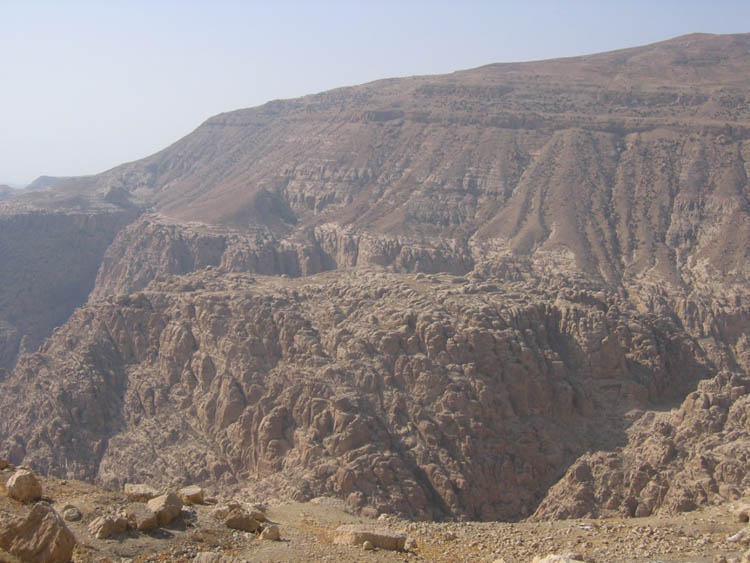In one of the Old Testament’s colder and more brutal episodes, King Amaziah of Judah (c. 801–783 B.C.E.), after having slain nearly 10,000 Edomites in battle near the southern end of the Dead Sea, is said to have thrown another 10,000 captives from the top of nearby Sela, where they were “dashed to pieces” (2 Chronicles 25:12; 2 Kings 14:7). While the Biblical account provides only vague clues as to where this horrible event took place (Sela simply means “rock” in Hebrew), the archaeology of a little-known mountaintop stronghold in southern Jordan may hold the answer.

Surrounded by deep ravines amid the rugged highlands of southern Jordan, the steep-sided “rock” of es-Sela may be where King Amaziah of Judah slaughtered 10,000 Edomites.
Located just 3 miles north of the Edomite capital of Bozrah (modern Buseirah) in the rugged highlands of southern Jordan is an imposing natural rock fortress that still carries the name es-Sela. Surrounded on all sides by deep ravines, the towering, steep-sided rock of es-Sela rises more than 600 feet above the surrounding valleys, culminating in a broad, flat summit that can only be reached by an ancient, well-hidden staircase that follows a narrow cleft in the eastern face of the mountain. Though es-Sela has not been excavated, surface finds from the summit indicate it was occupied during several periods (including the Early Bronze Age and Nabatean period), but saw its most extensive occupation and use during the early to mid-first millennium B.C.E., the time of the Biblical Edomites.

The gate area and natural rock tower that forms the only entrance to the mountaintop fortress of es-Sela. The narrow entryway leading into the city can be seen at lower left. Photo by Ian Rybak.
Es-Sela’s defensive character is immediately apparent after one ascends the many switchbacks of the worn staircase and passes through the narrow, rock-cut passageway that served as the stronghold’s only entrance. Flanking the passage are natural rock towers outfitted with guard chambers and topped by the remnants of well-built fortification walls. Positioned along the edges of the summit are numerous rock-cut rooms and chambers with strategic views over the surrounding valleys, while more than two dozen cisterns are carved in the plateau’s white sandstone bedrock, all of which collected vital, life-sustaining rain water through an interconnected system of channels and diversion walls.

Since es-Sela has not been excavated, it is difficult to know how or on what occasions the Edomites made use of their mountaintop fortress, although some sense of the site’s importance is evidenced by the mysterious rock-cut buildings and features that cover the summit. In addition to the myriad chambers and rooms carved into the summit’s numerous stony domes (which probably functioned as dwellings), there are more enigmatic features, like a carved staircase that seemingly goes nowhere, and a massive “throne-like” seat positioned in the center of an otherwise empty chamber. And on a large stone slab just peaking out of the soil, there is a worn but delicately carved image of a bull’s head, probably a depiction of the widely worshiped storm god Hadad.

Carved into the cliff face is this depiction of a Mesopotamian royal figure standing before several astral symbols. The scene likely depicts the Babylonian king Nabonidus, who campaigned through Edom in the mid-sixth century B.C.E. Photo by Arkady Alperovitch.
But the clearest indication of es-Sela’s importance during the time of the Edomites comes from a monumental relief carved into a sheer rock face about half way up the steepest part of the mountain. The heavily worn but clearly discernible Mesopotamian-style relief shows a royal figure with a conical cap carrying a long staff and facing symbols of the sun, moon and stars. These figures are surrounded by the faint traces of a lengthy neo-Babylonian cuneiform inscription, much too worn to be read. The scene’s iconography, however, strongly suggests it was carved to commemorate the conquest of es-Sela and Edom during the southern campaign of the Babylonian king Nabonidus (555–539 B.C.E.), who famously took up residence in northwest Arabia during much of his reign.*
Become a Member of Biblical Archaeology Society Now and Get More Than Half Off the Regular Price of the All-Access Pass!
Explore the world’s most intriguing Biblical scholarship
Dig into more than 9,000 articles in the Biblical Archaeology Society’s vast library plus much more with an All-Access pass.

Of course, none of this sheds any light on Amaziah’s slaughter of the Edomites as recorded in the Bible. Indeed, other candidates for Biblical Sela have been proposed, namely the steep-sided mountain of Umm el-Biyara in nearby Petra.** Although we won’t know more about es-Sela’s Edomite history until the site is systematically explored and excavated, the available evidence shows that this fascinating mountaintop stronghold was certainly an important place of refuge for the Edomites throughout the Iron Age, at least down to the time of Nabonidus and perhaps during the reign of Amaziah as well.
This Bible History Daily article was originally published in December 2012.
 Glenn J. Corbett is associate director of the ACOR’s Photo ArchiveAmerican Center of Oriental Research (ACOR) in Amman, Jordan, director of the Wadi Hafir Petroglyph Survey and contributing editor at the Biblical Archaeology Society. He received his Ph.D. in Near Eastern archaeology from the University of Chicago, where his research focused on the epigraphic and archaeological remains of pre-Islamic Arabia.
Glenn J. Corbett is associate director of the ACOR’s Photo ArchiveAmerican Center of Oriental Research (ACOR) in Amman, Jordan, director of the Wadi Hafir Petroglyph Survey and contributing editor at the Biblical Archaeology Society. He received his Ph.D. in Near Eastern archaeology from the University of Chicago, where his research focused on the epigraphic and archaeological remains of pre-Islamic Arabia.
Notes:
* See “Who Was Nabondius?” sidebar to Matt Waters, “Making (Up) History,” Archaeology Odyssey, November/December 2005.
** See Joseph J. Basile, “When People Lived at Petra,” Archaeology Odyssey, July/August 2000.
View more images from es-Sela:
The post The Edomite Stronghold of Sela appeared first on Biblical Archaeology Society.








0 Commentaires